
Jacob RabinowitzTHE ‘HER’ STORY OF THE GREAT WITCH-GODDESS : ANALYZING THE NARRATIVES OF HEKATE.*IIHecate’s character and narrative development.Kehl’s article in R.L. displays in skeleton form the present desiccated state of Hekate-studies -- if indeed one may apply so grand a term to so sparse a scholarship. After a listing of the various genealogical speculations and snippets of myth associated with Hekate, (1) he, and the authorities he draws on, can only conclude that she was, for her various contexts, an ancillary and unessential add-on. Kehl declares research at an impasse: the Great Goddess of Asia Minor is irrecoverable;(2) Hesiod's Hekate is authentic but baffling by its positive and non-chthonic depiction, as is the ambiguous late antique Hekate who is caelo Ereboque potens (Virg. Aen., 6: 247.) This is essentially the same position Heckenback reached in his article in Pauly-Wissowa nearly a century earlier: (3) Steuding in Ro. only escaped the problem of the “two Hekates” by reading lunar qualities into the earliest Hekate. Wilamowitz’ key to this problem has had only two defenders till now, neither of whom developed the idea.(4) Having stated the persistence of the double-Hekate problem, Kehl goes on to list the goddesses with whom Hekate was identified, her principal functions (gate-warder, crossroads-goddess, Mistress of the dead, of magic), and to overview her appearances in later classical thought — particularly the Chaldaen oracles.(5) Finally we are walked through the plastic and written record of her worship in Asia Minor, Greece, and Rome, though without enquiry into what the differing depictions may mean.(6) The most unsatisfactory part of this treatment is not that it does not resolve the primary problem, but that it presumes there is only one. Hekate possesses other striking characteristics, those of Goddess invoked in contest and struggle, special access to differing divine realms, and hymeneal/fertility functions, as well as association with Thessalian Enodia and the Moon. All these require examination regarding their relative antiquity and, where they are accretions, why they were so fused onto Hekate. There have been in our century only two books on Hekate, Kraus’ aesthetic treatment of the late Hekataia, and Johnston's study of Hekate in the Chaldaean oracles. Neither addresses the above-stated and central features of Hekate's being. Along with these there have been only three articles on Hekate, all of which focus exclusively on Hesiod's “Hymn”, and none of which look farther. Beyond this there are a handful of mentions and peripheral treatments in articles on other topics and especially in archaeological writings. To date no overview of the Goddess has been undertaken that materially differs from those of the 19th century encyclopaedists, as we shall show in our citations of the current literature that does exist on Hekate. Now for the first time we offer a thorough analysis of the Goddess in her many aspects, of which only one, her lunar identification, has ever been circumstantially discussed (Steuding.) In all the writings on Hekate extant, with the exception of Wilamowitz’ brief and brilliant remarks, it has been assumed that Hekate was always as she is in Roman poetry -- lunar, magical, and infernal. Thus the standard commentaries on all the texts I cite have been useless -- they do no more than refer one to classical citations regardless of time or provenance. A monolithic, constant Hekate is always presumed. Here you will find, complete, the extant substantial mentions of Hekate, never before so exhaustively collected, and arranged to show, as has never been done, her being as Great Mother and World Tree, and her infernal and triple-lunar development through conflation with other deities. The poverty of the scholarly apparatus is testimony, not to a want of diligence on my part, but to the ground-breaking nature of the work. Artemis.Artemis is a well-acclaimed Greek Goddess with whom Hekate was first associated and with whom she came to be most frequently and characteristically syncretized. Three (from our point of view) superficial but perhaps historically significant favoring factors must be mentioned in this connection. First, Artemis was, like Aphrodite, a goddess typically associated with exotic fertility goddesses (e.g., Anahita, Bendis, Bubastis, Ma, Nana,) -- her name was here used simply as a label, applied with some inaccuracy but much convenience to foreign religious phenomena, just as we might call the Koran "the Moslem Bible". On the face of it, more significance might attach to Artemis not being identified with a foreign female deity. Second, it is now generally accepted that Artemis, like Hekate, originally comes from Asia Minor, which might mean more points of common, and, third, the name Hekate -- coincidentally it seems -- is exactly what the feminine version of Artemis' brother Apollo's characteristic epithet (hekatos: “the one who hits his target from a great distance”) would be. Since Artemis is also an archer, this coincidence (as Wilamowitz believed, see above) could have been of decisive importance. But while the desire to explain a foreign goddess by equating her with a well known native one, and adventitious harmonies of name and place would have favored the conflation, the extraordinary and changing nature of Artemis provides the deeper meaning of this (and other) Artemis conflations. Now our reconstruction of Artemis' original nature and how it harmonized with that of Hekate (and other similar Near Eastern goddesses mentioned above) will depend on the model of Paleolithic and Neolithic religion generally accepted by Historians of religion, which we shall here attempt to set forth and defend concisely and soberly before proceeding. The basic presuppositions are: In fact, the results obtained using these suppositions are based on the most demanding definitions of control-group and reproducibility of results imaginable, for we have here "experiments" repeated at millennial intervals hemispheres apart; we may then fairly suggest that the burden of proof now lies with those skeptical of History of Religions methodology who castigate as reckless anything beyond bare catalogues of artifacts. We must of course keep in mind all that the evidence at our disposal cannot tell us: it only reveals Paleolithic and Neolithic religiosity in the broadest outline. Our generalizations are as far from revealing the detail, richness and historical background as the term "Scriptural Religion" is from exhausting the content of Judaism or Islam. The grotesque fantasies of Bachofen's spendthrift heirs, that is, Gimbutas and the more enthusiastic Neo-Pagan Feminists (Merlin Stone, etc.) who offer views of prehistory as a Matriarchal idyll go far beyond anything that can be responsibly inferred. We have good reason to believe that both Hekate and Artemis are linked (as their common Asia Minor origin would suggest) to Paleolithic religious motifs. The one in question is the Potnia Theron. Quite simply put, this label, "Mistress of the Wild Animals" is applied to any goddess figure represented with animals or herself possessing animal features. It is an iconographic type with particular prominence in the Paleolithic. (It also appears in a male version, called "Master of the Animals," but for our region the female type is paramount)(7). We know this figure from the Inuit Sedna, who sits at the bottom on the sea, and whose fingers are continuously chopped off to become whales, seals, walruses &c, which then nest in her hair.(8) A particularly clear Greek Potnia Theron appears on a 6th century BCE Boeotian Vase in the National Museum at Athens (Mus. # 5839) which shows a female figure, standing with arms outspread, surrounded by birds, beasts and fish. (Some scholars have tried to see Hekate in this figure, a point to which we will return).(9) The idea seems to be that the ‘Potnia Theron’ is the one responsible for the entire cycle of animal life, ensuring births to replenish the herds, and also causing periodic scarcity of game -- a most plausible religious focus for hunters who would see a divinity at work in their success or failure in the chase (which could indeed be a life and death affair.) Artemis earliest appears in literature with very Potnia Theron features: 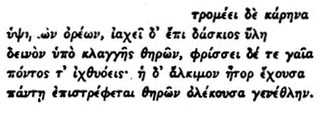
The peaks of the lofty mountains tremble and the shaded wood resounds terribly with the screams of wild beasts, Earth shudders and the sea teeming with fish, but the determined goddess roams everywhere killing the race of wild beasts, (h. Dian. 27. 6-10) (10). – an account which is balanced by her role of protectress of wild animals, particularly the young, which Aeschylus attests: 
For virgin Artemis bears jealous hate against the royal house, the eagle pair, who rend the unborn brood, insatiate -- yea, loathes their banquet on the quivering hare. (Aes. Ac. 134-37) (11) The Potnia Theron who dominates the Hunter-Gatherer Paleolithic gradually alters with the agricultural Neolithic. Iconographically, this is attested by goddess figures (still usually shown with animal retinue) that now appear with enlarged genitalia, pregnant, or otherwise offering an image of general fecundity. We know that Artemis evolved into an Agricultural "Great Mother" -- she was worshipped in this matronly guise in the more backward regions of Greece (Laconia, Arcadia) into historical times. At some pre-Homeric point Artemis fused with Leto's daughter, and evolved again into a youthful virgin goddess — fit sister for the young god Apollo. This is the Artemis best known to us, an Artemis whose only traces of the Potnia Theron are her accompanying dog-pack and taste for the hunt. This Artemis' last trace of the Great Mother is a vague association with childbirth. In Homer's and Hesiod's time the incongruities of the Greek religious synthesis were being ironed out, and inconvenient features left over from a god's earlier stages were sometimes transferred to another. So it fell out with Artemis and Hekate. Hekate appears in Greece as a Great Mother (an identification we shall establish in detail later in this essay) described by Hesiod as a source of fertility especially as regards domesticated animals (sheep, goats, oxen (Hes. Theog. 445-347).(12). The ‘Great Mother Hekate’ absorbs the ‘Great Mother Artemis’ and the result is Hekate-Artemis who Hekate was not unique in receiving Artemis’ outgrown associations: they seem to have been tossed around from goddess to goddess till they finally stuck. The evidence is Hesiod's identification of Hekate with Iphigeneia:  I know that Hesiod in his Catalogue of women represented that Iphigeneia was not killed but, by the will of Artemis, became Hekate. (PAUS. 1: 43: 1)(14) Pausanias’ information seems confirmed by a Pompeian wall-painting of the sacrifice of Iphigeneia which features a torch-bearing deity.(15) We can interpret this as mythic shorthand for actual religious history: Iphigeneia was plausibly a goddess before she became a mortal player in Artemis' mythology, and Burkert reads the line as evidence that Iphigeneia took over the Chthonic aspect of Artemis.(16) To which we may add, I think without audacity, that when Iphigeneia was degraded to heroic level from godhood, Hekate took over Iphigeneia's chthonic divinity. The first trace of the completed synthesis of Artemis' Great-Mother aspect with Hekate as something everyone could be expected to know appears about 200 years after Hesiod, in the 5th century, when Aeschylus' chorus of suppliant maidens sings: 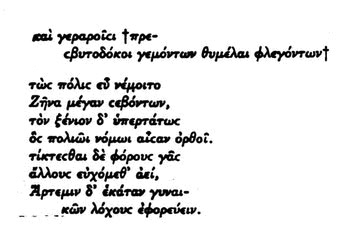 “And may the altars, whereat the elders gather, blaze in honor of venerable men. Thus may their State be regulated well, if they hold in awe mighty Zeus, and most of all, Zeus the warden of guest-right, who by venerable enactment guideth destiny aright. And that other guardian be always renewed, we pray; and that Artemis-Hekate watch over the child-bed of their women.(17) (Aesch. Hiket. 667-77)(18). The motivation for the transfer is not however entirely a matter of sparing Apollo's unmarried sister an embarrassing maternity. What is at issue is the more complex chthonic associations of the Great mother concept, which lead the late Hekate-Artemis to be conflated with Greek Selene and Mene, old Italic Diana, Cretan Eileithyia and Britomartis (Dictynna), Eleusinian Daire and Brimo, Ephesian Diana or Upis, and Thessalian Enodia.(20) (It should here be noted that, though not quite ciphers, little is known about any of these goddesses: and for the most part the context wherein the identification with Hekate-Artemis occurs constitutes a major share of the evidence we have on that deity from any source. None, however, are without strong chthonic and fertility associations). The reasons for this rift between the Chthonic and Ouranian deities, which runs like a geologic fault line through the history of Greek religion, shall be discussed below later on. As an addendum to this section we note that we have above given the entire dossier of quotations for the early literary conflation of Hekate with Artemis. Aristophanes' and Theokritos' equations of Hekate and Artemis are the one too facetious and the other too late to illuminate the relation between the goddesses. Nonetheless, for the convenience of the reader we give the citations. For Aristophanes, Hekate, Dictynna and Artemis were interchangeable names -- so they appear in these lines: 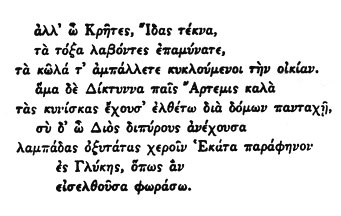 Children of Ida's snows, — a pleasant fusion of Hekate the torch-bearer and companion on the search for Kore with Artemis the huntress. The equation of the two sorts of "hunting" is of course ludicrous and entirely appropriate as we have here Aristophanes’ imagining of Aeschylus delivering a parody of Euripides' over-ripe style and mythological vagaries. This is not to be taken as in any wise a document in Greek religion, as the comic impulse coupled with the elaborate nature of the voice employed give complete assurance that a far-fetched connection is in play. We have in Theokritus: 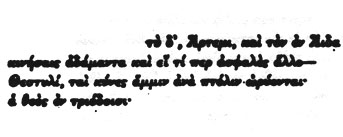 “0 Artemis, as thou movest the adamant that is at the door of Hades, so mayest thou move all else that is unmovable (that stands in the way of my project.) Hark, Thestylis, where the dogs howl in the town. Sure the Goddess is at these crossroads”. (Theok., II: (33-36) (21) Goddess of Contests. The gate-guardian of Hades can be none other than Hekate, but the logic of the Artemis allusion is not apparent. We can only conclude that the identification was so common that Artemis was an acceptable alternate name for Hekate and could be used merely to add variety. And when men arm themselves for the battle that destroys men, then the goddess is at hand to give victory and grant glory readily to whom she will: 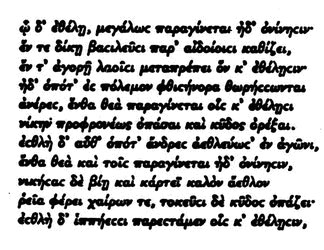 Whom she will she greatly aids and advances: Good is she also when men contend at the games, for there too the goddess is with them and profits them: and he who by might and strength gets the victory wins the rich prize easily with joy, and brings glory to his parents. And she is good to stand by horsemen, whom she will... (Hesiod. Theog. 429-39 )(22). As is clear from Hesiod's enumeration of activities in which Hekate helps, she is a goddess of agon, a word which may mean “assembly; contest; struggle; danger; battle; legal action, trial”. The agon, which is a quintessentially Greek preoccupation, constitutes her most Hellenic feature, and one that does not fit in with the others associated with her. To make the case that this feature is a Hesiodic invention, let us examine the record of Hekate of the Agon. It is found in the assistance Hekate (through Medea) gives Jason for his contests in Apollonius' Argonautica Jason invokes her as “Hekate-Brimo, helper in contests”, (Arg. 3: 1211, passage given in full in App. 2.) In Ovid's treatment of the same story she is the goddess called upon especially in audacious undertakings, ingentibus ausis. (23). Hekate of attempts and ventures is addressed by Antigone watching from the roof as the armies of Polyneices are ranged before Thebes: “O Hecate, dread child of Latona! the plain is one blaze of bronze!” (Eur. Phoen. 109-11)(24). The fusion with Artemis (in her Homeric death-dealing character) is here also appropriate insofar as a slaughter is in the offering. Similar is 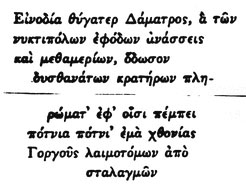
Daughter of Demeter, Enodia, hear, This refers to Creusa's plan to poison Ion who she thinks is scheming to wrest the throne from Erectheus. We shall explain the use of Enodia as a Hekate epithet below.(26) The chorus goes on -to explain that if the poison doesn't work, Creusa will try sword, noose, etc. (0361-68) Creusa's violent resolution to dare all is, like the Medea passage where Hekate is mentioned, a parade example of the Hesiodic and heroic Hekate, favorer of the aeonistes. a word we might unpoetically but for our purposes clearly render in English by the boxing-term “the contender”.(27) We find a similar invocation of Hekate in Euripides' Medea (lines 392-98). The agonic quality of Hekate is given particular prominence only by Hesiod, the deliberately archaizing Apollonius and, in his shadow, Ovid, who wish to establish an archaic heroic flavor which the Hesiod reference qua Hesiod reference would establish. Otherwise there are the two brief references in Euripides we have cited - and there the dossier virtually ends. The only other note is a historical one at Agrai in Attica there was a yearly procession in honor of Hekate for her help at the battle of Marathon (Plut. de Herodot. Malig. 26: p. 862). The weak and sparse testimony of Hekate’s agonistic character, suggests that it was a Hesiodic attempt to make Hekate palatable to Greeks, and so part of his general apologia. If there is more to the notion, that more is tributary to Hekate’s role of intercessor, which we will consider below. Mother.Hekate's role as Great Mother is so central and essential to her that the testimony is extremely abundant and diverse. Here we shall review first the parallel with Kybele, then the direct and indirect evidence for Hekate from Greece, (Kourotrophos in Hesiod and in the fifth century BCE, association with Hermes, and Nymph-like depiction,) concluding with the signification of her symbolic representation, as sacred pole. Kybele.The evidence of epithets, inscriptions and depictions makes clear that Hekate was honored as a Great Mother in Caria just as Kybele was in Phrygia.(28) A late and tantalizing echo of the parallel is found in Lucian's (fl. AD 120) Herodotean send-up (done in Ionic dialect) Dea Suria, which equates the rites of Kybele with the Mysteries of Hekate practiced on Samothrace : (29).
There is also another holy story I heard from a wise man that the goddess (the Syrian Atargatis) is actually Kybele and the service founded by Attis. Attis was a Lydian, the first to teach Cybele's ceremonies. And all the mysteries that the Phrygians and Lydians and Samothracians perform, they learned from Attis (italics mine.) (Lucian, Dea Syria 15) (30). Of course we cannot accept the simple identification of Hekate's and Kybele's mysteries here suggested, but it is a particularly interesting document of the similarities in worship offered the two goddesses. The particular relevance of the citation here is that all mystery religion is based on scenarios of symbolic rebirth, and the goddess who occupies center stage is necessarily a goddess of fertility. Another record for the antiquity of Hekate's and Kybele's parallel mothering role appears in the Argonautica where Rhea-Kybele is described as “...mother of all the blessed gods...”. (Ap.Rh. Arg. 1: 1094)(31). and, four lines later: 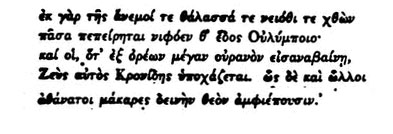
“...by her power the winds and the sea and all the earth below and the snowy seat of Olympus are complete; and to her, when from the mountains she ascends the mighty heaven, Zeus himself, the son of Kronus, gives place. In like manner the rest of the immortal blessed ones reverence the dread goddess”. All the earth below and the snowy seat of Olympus are complete; and to her, when from the mountains she ascends the mighty heaven, Zeus himself, the son of Cronus, gives place. In like manner the rest of the immortal blessed ones reverence the dread goddess”. (A.R. Arg. 1: 1098-1102)(32). This description echoes Hesiod's account of Hekate: 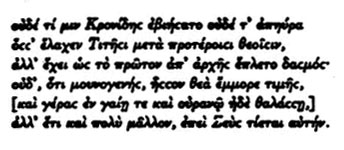
The son of Cronus did her no wrong nor took anything away from all that was her portion among the former Titan gods: but she holds as the division was at the first from the beginning, privilege both in earth, and in heaven, and in sea. Also, because she is an only child, the goddess receives not less honor, but much more still, for Zeus honors her”.(Hes. Theog. 423-28). The detailed precision of the parallel description - participation in all realms and special deference received from the gods, as well as the great-mother function, makes clear the extent to which the ancients could see in the Magna Mater, Kybele, virtually another Hekate, and in Hekate a very definite Magna Mater. beyond reasonable doubt,(33) (particularly when we recall that Apollonius is without doubt deliberately using Hesiod's passage to provide a plausible and impressive description of Kybele.)Kourotrophos. The Earth is the archetype of tireless fecundity, and the goddesses who represent it are necessarily figures of Fertility, “Great Mothers”. Steuding makes the valuable observation that Hekate's shrines in Asia Minor, the place of her oldest and most characteristic worship, are inland - which supports our understanding of her as primarily Earth-Goddess,(34) That she is not directly associated with the earth in the Theogony passage, but only described as generally favoring agricultural pursuits, may be attributed to the presence of a widespread cult of Gaia in Greece.(35) But if Gaia had already been equated with the earth and so deprived Hekate of her most obvious and appropriate association, the actual day-today work of the earth-goddess, patroness of birth and fertility as regards all living things, is attested Hesiod far more explicitly for Hekate than for Gaia: 
...and to those whose business is in the grey discomfortable sea, and who pray to Hecate and the loud-crashing Earth-Shaker, easily the glorious goddess gives great catch, and easily she takes it away as soon as seen, if so she will. She is good in the byre with Hermes to increase the stock. The droves of kine and wide herds of goats and flocks of fleecy sheep, if she will, she increases from a few, or makes many to be less. So then, albeit her mother's only child, she is honoured amongst all the deathless gods. And the son of Cronus made her a nurse of the young who after her saw with their eyes the light of all-seeing Dawn. So, from the beginning, she is a nurse of the young, and these are her honors. (Hes. Theog. 440-52)(36). These lines contain a fascinating and revelatory contradiction, which was not wasted on West: (37) how can she have fostered all born since her own birth (met akeinen) and have held this position from the beginning (ex_arches) if her commission dates from Zeus' bestowal ? This is an example of the conflict which sometimes arises between Hesiod's agenda (Zeus-aggrandizement) and his material, presumably where details are too vital or well known to be omitted, however inconvenient they may be theologically. It would be a strained reading to resolve the conflicting phrases by assuming that she gave birth to herself. Better to suppose that she was originally an All-Mother, and that her somewhat awkward subordination here to Zeus as regards her primordial function is backhanded evidence that it was very central to the earliest Greek Hekate-conception. Further evidence that Hesiod's contradictory formulation of Hekate's power reflects a genuine theological problem (and not just a philological quibble) comes from the extraordinary confirmation of Hekate's time, her honor and authority: Aphrodite has time “from the beginning” (Theog. 203-04) and Styx has it from Zeus (Theog. 399-400) but Hekate is alone in the Theogony in possessing legitimated power which is both Titanic/primordial and Zeus-bestowed.(38) That the Hekate's birth-fostering role was felt by others, and much later than Hesiod, to antedate Zeus' bestowal seems confirmed by the Hekate frieze on the east side of the Lagina Temple which shows Hekate assisting at the birth of Zeus, giving the substitution-stone to Cronus.(39) In further confirmation of the centrality of the nursing role we may note that in Hesiod's Hymn Hermes as Consort.The relation to Hermes calls for a small digression on the consort of the Great Mother. It is a universal phenomenon, adequately described in the first chapters of Eliade's Traite that the archaic god and goddess, Heaven and Earth, are gradually supplanted by more dynamic and active deities, those that maintain rather than those that ordain life, typically weather-god and agricultural Great Mother. In the Nile-to-Oxus, as in some other regions, the chief male god is not only reduced from all-powerful autonomy to mere partner in a divine marriage, (as Mesopotamian Anu was replaced by Enlil, husband of “the Great Cow” Beltu) but is further tangentialized to the status of son-and-lover, like the well known dying and reviving gods Tammuz, Attis and Adonis .(40) This seems to be what happened to the surviving Neolithic Greek goddesses, who characteristically take ithyphallic Hermes as consort. Examples would be Persephone, whose glance puts Hermes into that ready condition (41) and the chthonic Artemis or Aphrodite who bears Eros to Hermes (Cic. de Nat. Deor. 3: 23: 60). Other examples would be Brimo honored with Hermes at Pherae (42) (Prop. 2: 2: 11) and Dea Tacita who is associated with Mercurius in Ov. Fasti 2: 583 ff .(43) At the end of her classical career (Magical Papyri, 2-4th centuries AD), when Hekate takes on the cosmic powers of an Allmother, this Hermes seems to reappear within her. She is now autophues, “self-begotten” (PMG, 2274), Hermen te kai Hekaten homou arsenothelun ernos. “Hermes and Hekate at once, male-female child together” (PMG 2699-10), expressing by this androgyny the self-sufficiency of a perfect and total being. The constant presence of Hermes as Hekate’s male consort, from the first mention in Hesiod to the last in the Magical Papyri 1200 years later, marks the fertility function as in the highest degree essential to Hekate. Kourotrophos in the 5th Century.Here we resume the thread of Hekate' s general birth-favoring and fostering activity as attested in Hesiod. The same is recorded of her in the 5th century BCE, in the scholion to Arist. Vesp. 804, which calls her kourotrophos, and also where Hekate appears equated with Hymen in Cassandra's 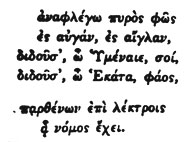
Therefore my torch is borne The identification of Hekate and Hymen is somewhat nuanced. She does appear on a kalyx crater from Ferrara(45) at a wedding with her torch, so she isn't necessarily an ill-fated wedding guest, though in this context, Cassandra being led off to Agamemnon’s bed, an act which will bring about both their deaths at his wife's hands, it may more logically Hekate’s dark side which is being called into play. In any event, marriage in the ancient world meant children -- there is no Epithalamion which does not express the wish for offspring — and a hymeneal character is by definition associated with kourotrophy. Nymph.Further, Hekate has a nymph-like appearance, attested in the Demeter. There she appears:  “…only youthful, tender-hearted Hecate, with bright head-band, the daughter of Persaeus, in her bright headband, heard the girl (Persephone) from her cave... (Dem. 24-25)(46). To comment: “of youthful spirit and tender (atala phroneousa) wearing”, “a bright head-band (liparokredemnos), and emerging from a cave” -- a common dwelling-place for nymphs in classical literature, (cf. Vergil's nympharum antrum). These details may be of a piece with her kourotrophy. Nymphs (47) that is to say water-spirits, are usually associated with springs but also dwell in caves where there is water. They are spirits of generation and kourotrophoi -- as shown by their frequently bringing up children and teaching them to become heroes:
Also she (Tethys) brought forth a holy company of daughters, who with the lord Apollo and the Rivers have youths in their keeping (andras kourizousi)...”. (Hes.Theog. 346-48, Evelyn-White trans.; cf. Eur. Hel. 624 ff.). The water-cave-fertility pattern is here in evidence and fits in well with what else we know of Hekate and her cognate goddesses. Sacred Pole.The above attestations of Hekate's maternal character are confirmed by the central pole of the hekataion, whose meaning is to be sought in the context of ancient Near Eastern concepts of numinous place, considered in detail as they relate to witch-depiction below. Briefly, these are water, trees and heights.(48) It is the tree which particularly concerns us here. Especially frequent in Mesopotamian iconography, trees are used particularly as fertility symbols, and biblical denunciations of worship: “...on the hills, under every verdant tree...” (Dt. 12:2, I K.14:23, etc.) provide sour confirmation of the pattern. A like practice was the marking of sacred places with poles. This would make particular sense in regions where trees were uncommon -- such as Iraq. (It will be remembered that Gilgamesh’s great quest was to a distant land --probably Lebanon -- to bring back cedar. (49)) Again, the Bible is quite forthcoming on this point. On the “high places”, bamoth it was customary to set up a massebah, an upright stone symbolic of male deity, and its female equivalent, the asherah or sacred pole. Asherah means in Hebrew “fertility” and is the name applied by the Hebrews and the Canaanites to that goddess (and her pole-fetish) whom the Amorites called Ashtoreth, the Akkadians Astarte and the Sumerians Inanna. I quote de Vaux (p. 286): “The Asherah itself was made of wood (Jg. 6:26), cut into shape by man (Ex.34:13, Jg. 6:25)...it must have been a kind of post or stake. It is impossible to be precise about its appearance and there is no proof that the post was carved to look like a goddess”. The Sumerian version of the asherah is the gatepost-emblem of Inanna which, singly or in pairs, is her symbol both in the earliest pictographic script and in art from her native city-state Uruk -- a pair of upright posts, each surmounted by a ring and a streamer. It is suggested that these designate the entrance to her temple — possibly bundles of reeds tied with bands. Some houses in modern Iraq are still constructed with such posts. The ring and streamer would have had this use: a pole passed through the ring i would support a mat which was lowered to close or raised and secured by the streamers to open the building. This post was later used as a “sentry”, an apotropaic gate-post warder -- a propulaia or hekataion. There is a school of thought which holds the post to be a female form and schematic totem of Inanna. Both explanations could be true.(50) Further examples of the asherah are unnecessary. Sumerian thought traveled over the entire ancient Nile-to Oxus.(51) Mesopotamian cylinder seals have been found at Troy, the pharaohs carried on diplomatic correspondence in Akkadian, and most importantly for our enquiry, Near Eastern mythology surfaces in Hesiod. Unquestionably then the asherah was known in ancient Turkey and even to Crete, whose “tubular idols” (52) strikingly echo the Asherah figures of ancient Israel,(53) and the association of trees with goddess-worship there as well is attested on Mycenaean gems -- such as show a goddess seated by a tree which Nilsson connects with “the tree cult” and the simple pillars heraldically flanked by griffins and lions (as were the “mother goddesses” of Asia Minor, and the “Mother of the Mountains” from Knossos). The sacred tree or pole participates in what Eliade calls the Symbolism of the Center. This shall presently be discussed in its implications for Hekate's place in a three-realm cosmology: here we need only note its generative nature. The Center is identified with the origin-point of the original creation, like the Ben-ben or pyramidal hill that first rose from the waters of Nun (Chaos) in Egyptian mythology. It is the point at which creative growth first breaks forth from sterile disorder and ever after radiates life-giving power. In Egypt this was always symbolized by the pyramid, and it was doubtless the pyramid's primordial associations with the origins of life that made it an ideal locus for the continued life of the dead. Elsewhere a tree was frequently the sign of this vivifying center, like the tree of immortality that grew in the center of Eden, or the Norse world-axis tree Yggdrasil, which, fed on by various animals, from dragon to bee, architecturally sustains and physically nourishes the worlds: of Yggdrasil it is reported in the Eddaic Svipdagsmal: “Tell me this, then, Fjolsvid”, Svipdag said: 'What issues from the seed of this mighty tree that neither axe nor fire will fell?” “Women in childbirth cook the fruit” said the giant. “Then the hidden child is delivered safely. That's why people esteem it.” (54) a rather direct parallel with kourotrophic Hekate whose precision will come clearer when we consider her as World-Tree. A passage in Apollonius describes, in reference to Hekate’s cognate goddess Cybele, rites which may be taken as emblematic of every feature of the hypothetical development of Hekate from a goddess worshipped in groves on high places, to a wooden figure or post representing her as "tree-goddess" to the late, humanized depiction of her with oak-leaves in her hair, not omitting the funereal overtones -- here supplied by Rhea-Kybele's attendants:
Now there was a sturdy stump of vine that By Lucan's time the recollection of these wooden goddess images was an embarrassment and an incomprehension. Thus he writes, with civilized scorn, of “...simulacraque maesta deorum These are described as the statuary of an evil grove, the site of primeval barbaric religion involving human sacrifices for chthonic gods. Human sacrifice in a chthonic context (cf. Rex Nemorensis) suggests fertility religion, and the particular relevance of wooden images to goddess-worship is described below in I: B: 4. The entire passage develops, negatively, but in considerable detail, tree-sacrality. We might similarly read a deionization of Hekate's original dendric/fertility/kourotrophic character in Ap. Rhod. Arg. 3. 1214 ff., (Hekate’s theophany, “...scary serpents in oaken sprays crowned her...” ) and in the accompanying scholion which quotes Sophocles' Rhizotomoi chorus: 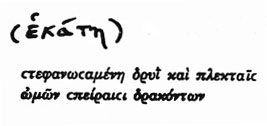 “...Hekate... crowned with oak and the woven coils of fierce serpents...” (my trans.) (Radt. 535)  ...she was crowned round about with horrible serpents entwined among oak-boughs; (Arg. 3: 1214-15)(57). A “missing link” between the Mycenaean Tree-Goddesses, the Ashera Poles, etc. and the classical Greek Hekataion seems to be provided by an 8th century Boeotian stamped amphora, showing a goddess-figure, flanked by lions, who uplifts protective or blessing arms over two female figure who embrace her closely from either side (National Museum, Athens, Mus. # 5898). “The goddess wears a crown with branches projecting on either side, and the whole tableau surmounts a frieze of animals, possibly deer”. Marquardt goes so far as to say: “The vase appears to depict a kourotrophos with arms raised over the heads of young women standing closely by her sides. In this respect, the goddess could represent Hecate. The pose of the figures, in fact, calls to mind the later Hecataea which depict maidens encircling a harm of Hecate”. (59) The lions, kourotrophy, hekataion-like pose with the maidens, branch-crown, and source in Boeotia, a center of Hekate worship at nearly the same time Hesiod was writing his hymn, puts the identification with Hekate beyond reasonable dispute. Hekate’s later lunar identification, to be discussed below, further confirms Hekate’s image as ‘great mother’, and maintains her in that character to the end of antiquity. The role of nurturing great mother, kourotrophos as central and original to Hekate, is stated by Hesiod, and confirmed by her hymeneal function, nymph (generation-spirit) -like characteristics, the parallel with the Great Mother Cybele, and above all the Hekataion’s central pole as a fertility fetish of a kind attested from Crete to Sumer. This valuation of Hekate re-emerges explicitly at the end of antiquity in the P.G.M. where she is called “...mother of gods and men, and Nature, Mother of all things...” (PM, 2832-34. ) Minor Excursus One: Near Eastern Pantheons.In evaluating our frequent uses of Kybele to explicate Hekate one must bear in mind fluidity of the Near Eastern pantheons, where on their own turf every god or goddess is supreme. Inanna is the principal goddess in the Gilgamesh cycle, in the form it received at Uruk, her own city. Ereshkigal is in this epic the terrible death goddess, but Ereshkigal is elsewhere called the elder sister of Ishtar (Inanna) and was possibly herself once a sky goddess,(60) who no doubt received Inanna-like honor and description in the city that claimed her for patron. Likewise the Supreme god of the Mesopotamia creation poem changed from Marduk to Ashur -- without any alteration of attributes --when Ashur's Assyria took the political rule once held by Marduk's Babylon.(61) Similarly in Egypt virtually identical supreme-god attributes are given Atum in Heliopolis, Ptah in Memphis, and Khnum at Elephantine. For the Nile-to-Oxus region there is no firm codification of the gods such as was achieved by Homer and Hesiod -- thus we can assume that supreme and general attributes were given in turn to the local regnant deity. What this, means is that Kybele parallels will be valid to fix the broad outline, but not the nice detail, of Hekate's being. World Tree.In the Hesiodic account Hekate has access to all the three realms. Heaven, Sea and Earth. 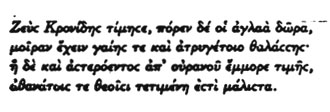 He (Zeus) gave her splendid gifts, to have a share of the earth (yaies) and the unfruitful sea. She received honour also in starry heaven, and is honoured exceedingly by the deathless gods. (Theog. 412-15) “Earth” would also include the Chthonic realm, the World of the Dead.(62) Similarly indicative of her world-bridging range is Hekate's role as an intermediary in prayer (63)
“For to this day, whenever any one of the men on earth offers rich sacrifices and prays for favor (hilaskontai) according to custom, he calls upon Hecate. Great honor comes full easily to him whose prayers the goddess receives favorably, and she bestows wealth upon him; for the power surely is with her”. (Hes. Theog. 416-20). Marquardt reads and interprets the invoking of Hekate whenever a man wishes to gain the favor of the gods in general (hilaskontai) “... as though Hekate were an intermediary between men and the gods. Such an interpretation would not be inconsistent with her personal involvement in men's lives, or with her extraordinary time among the gods." (A Portrait of Hecate. p. 245.) As usual Marquardt is exactly right. Hekate's role as intermediary or messenger appears in Pindar's Paean for the Abderans(64) in which she was presumably included for their gratification as she surfaces nowhere else in the poet's extant works. There she is shown to this extent:  “It was the first of the month when this befell, and the gracious Hecate, the maid of the ruddy feet, was thereby sending us a message that was longing for fulfillment...” Pind. Paen. 2; 48-50.(65) Again we find Hekate as mediator of prayer, helping as a spiritual catalyst for areas outside her especial province, when Ovid's Medea plans to restore Aeson's youth: “...statuitque aras e caespite binas, dexteriore Hecates, ast laeva parte Iuventae”. (Ov. Met. 7:240-41) This role is complemented by the myth given in a scholion to Theokritus 2: 11/12 b., which states that Hekate was the daughter of Zeus and Hera, and in her original nature, before she became accidentally involved with death and birth, was called angellos, messenger. The currency of this epithet is shown in five inscriptions from the Stratoniceia-Lagina area to Theios Angellos, Theion Angellicon, Agathos Angellos, and Angellos Hosios-Dikaios, in two of which the angel is paired with Zeus Hypsistos -- which Sokolowski, following Guarducci (Studi e mater. stor. rel. 15, 1939, p: 85,) and Laumonier (Bull. Corr. Hell. 1934. pp. 338-39,) reads as referring to Hekate and Zeus Panamaros.(67) Hekate-Artemis is called ‘Angellos’ at Syracuse (Hesych.) while in the inventory of the temple of Hera at Samos (Michel, Receuil Inscr. Gr. 832: 21-22, 37) we find a wimple (kredemnos) and gown (kiton) belonging to the ‘good angel’ (he euangellis) and in the inventory of the sanctuary at Dindymus from the imperial period there is an account ( Didyma II. Inschriften. no. 405: 9-11 and p. 243) of building the walled enclosure of the Angel (ton peribolon tes angellou) Sokolowski and the commentators on these inscriptions connect them with the worship of Artemis-Hekate. (68) Further, Sokolowski sees Hekate's role as messenger between worlds, particularly between ours and the world of the dead, as suggested in her role in the search for Persephone, and cites inscriptions that show this epithet applied to both her and Hermes as angeloi katakthonoi. literally “angels from underground”, a late usage amply instanced in the Magical papyri.(69) Due to her access to the three realms Hekate can act as a conduit, a connection between man and the gods, a cosmic gate. The form of the Hekataion (discussed in detail as to appearance and origin above) is particularly relevant to Hekate’s inter- and underworld range especially by virtue of its material - wood. Images of the gods were apparently made of wood long before they were carved in stone, as will be recalled from the Cybele passage: “luminis exigui fuerat prope tempia recessus speluncae similis, nativo pumice tectus, religione sacer prisca, quo multa sacerdos lignea contulerat veterum simulacra deorum”. Ovid. Met. 10: 691-694). Hard by the temple was a dimly lighted cave-like place, built of soft native rock, hallowed by ancient religious veneration, where the priest had set many wooden images of the olden gods… (70) And in the passage on Aegina that leads to the description of Alkamenes’ triple Hekate, where Pausanias says: 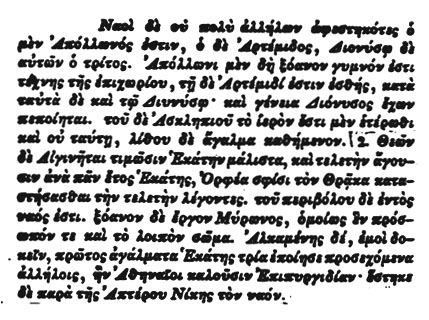 There are three temples close together, one of Apollo, one of Artemis, and a third of Dionysus. Apollo has a naked wooden (xoanon) image of native workmanship, but Artemis is dressed, and so too is Dionysus, who is, moreover, represented with a beard...Of the gods, the Aeginetans worship most Hekate... Within the enclosure is a temple; its wooden image (xoanon) is the work of Myron and has one face and one body. (Paus. Descr. Gr. 30: I ,1-2) More than just an ‘archaic’ aspect is implied by the use of wood for images of Hekate and Cybele because they were fertility goddesses who could be represented by a sacred pole. This is particularly pertinent to Hekate who continues to be represented in wood in the fifth century:  “A Hekataion is an image of Hekate carved of wood”. -- scholion to Aristoph. Lysist. 63-64. Additionally, it should be borne in mind that the pole of the hekataion continued as a compositional feature of her statues even when they came to be made from marble, and remained so through the latest hekataia. We have already discussed the archetypal or archaic significations of sacred poles and trees as fertility symbols: additionally they usually signify a bridge between heaven and earth. All ritual trees and posts used in religious ceremonies partake to some extent of the character of the Universal Tree which marks the Centre of the World (e.g, the ‘Arbor Mundi’, Cabbalistic Tree of Life, the Germanic World-Tree, etc.) and provides the bridge by which communication is possible between the realms of Hell, Earth and Heaven. Further examples are the Poteau Mitain at the center of the Humfo or Voodoo temple by which the gods descend (71); the sacrificial stake (yupa) of Vedic India concerning which the Satapatha Brahmana (III, 7, l, 4) says “With thy summit thou dost hold up the Heavens, with thy branches thou fillest the air, with thy foot thou steadiest the earth”; Jacob's Ladder; the drum of North and Central Asiatic shamanism, which the shaman “rides” in his ecstatic journeys to Heaven and Hell, and which is made of the very wood of the world-tree. (72) The symbolism of the tree which spans the three worlds might also go some ways towards explaining why the Hekataion is set up where three roads meet, the triodos. Some examples of the polyvalent “world-tree” motif now having been set forth, we will regard with knowing eye the Sophocles Rhizotomoi fragment, preserved by the scholiast of Ap. Rhod. Arg..: 3. 1214 ff., which suggests a dendric Hekate (the crown of oak-shoots) and describes her three-realm range (Hell being suggested by the serpents.) The chorus sings: 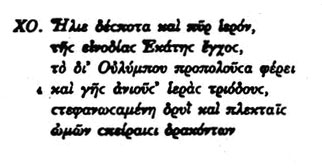 “O Lord Helios, O sacred flame of the torch wayfaring Hekate holds by her, which she carries as she ranges in the realm of Olympus or returns to the earth (where are) the crossroads, her sacred place, crowned with oak and the woven coils of fierce serpents...” Radt, p.535. (73) Six hundred years later Lucan presents essentially the same image: his Hekate is able to access the realm of the dead: “Persephone, nostraeque Hecates pars ultima, per And at the same time she is able visit the world of the gods: For Lucan as for Sophocles Hecate freely skips from realm to realm. Other evidence of Hekate's intermediary character is her identification with Iris, the Rainbow: Hekate seems to have replaced or syncretized with Iris on an island near Delos which came to be known as Hekate’s nesos : Hecate's Isle. (Semos on Athen. 14:53 p.645b; Harpokr. and Suid. s.v.) Of a piece with the above is Hekate's depiction as gate-guardian, holder of the keys that unlock the realms. The earliest evidence for this role is the placement of the Hekataion before doors, mezuzzah-like, and the archaeological evidence that her Lagina shrine featured a procession in which the priestess bore a key, (discussed in detail below). Hekate's gate-guardian function and realm-accessing later "tends to be presented in pure infernal rather than general terms:  “O Artemis (i.e. Hekate. ) as thou tnovest "the adamant that is at the door of Death, so mayst thou move all else that is unmovable. Hark, Thestylis, where the dogs howl in the town. Sure the Goddess is at these crossroads”. (Theok. II: 33-36) Paralleling this we have the entrance to Hell in Virgil, the groves of Avernus, are Triviae luci. “the groves of Trivia (i.e. Hekate)”, (Vir. Aen. 6: 13), and the Sybil of Cumae holds her position there by Hekate’s appointment (Hecate praefecit: Aen. 6: 118) The rite by which Aeneas gains entrance to hell, modeled on the Necromancy of Odysseus, departs from its model most notably by being prefaced by an invocation of Hekate, explicitly in her role of bridge between the realms: “voce vocans Hecaten caeloque Ereboque potentem”. (Vir. Aen. 6:247  and addressed by a magician who says I “...possess your key. I opened the bar of Kerberos...”(2293-94).  Elsewhere she is invoked in the name of her key and thrice-locked door (2335; 37)  and called “...you who’ve parted the gates of steel unbreakable” (2719-21),  “gate-breaker” (2751),  and quite simply the “key” (7:786.)(75) At this point we are equipped to understand the attributes of the classical Hekataia, those found near Athens and before the 3rd century BC. The dog is included with reference to Hekate's characteristic purification sacrifices, the torch a reference to her ability to enter or access the underworld, the fruit is for her fertility character, and the ewer and libation 'bowl would stand for her facilitating prayer at sacrifices where libations were poured from the ewer to the bowl, and then on the ground or the altar. These explanations are my own and tentative, but seem the obvious ones. Petersen and Steuding, looking for lunar symbolism in the early Hekate, imposed it on these objects, and Kraus does not examine these questions of meaning. My explanations of the attributes are accordingly the first of their kind. Enodia.Pindar’s contemporary Bacchylides makes Hekate the daughter of Night (Sch. A.R. 3: 467; fg. 40 B III 583 = 31 Blass-Snell), which makes immediate sense for us, to whom Hekate is best known as a goddess associated with magic and the dead — a character which little of the material so far covered prepares us for. Factors favoring this development might have been her access to all realms (Theog. 412-15), which would include under-earth, and the funereal aspect which is a feature of all Mother-goddesses in so far as the earth is at once womb and tomb to all that lives. Nonetheless, a connection with underearth such as every fertility goddess has, and even the World-Tree’s access to the Dead-Realm, are insufficient to explain Hekate’s special development as goddess of mortuaries, moon and magic. Further, the absence of chthonic/funereal/lunar characteristics in Hesiod’s “Hymn” (76) the Hymn to Demeter. and all early plastic depiction reject an infernal Ur-Hekate. Wilamowitz shows (77) that, by the literary and archaeological record, Hekate was, during the fifth century, gradually conflated with the Thessalian goddess Enodia,(78) of whose original character we know little beyond her name and that she possesses Mothering features (dedicatory inscriptions from women and mothers), war associated with the chthonic Zeus Meilichios in Larissa (79), and appears on a coin from Pherae on horseback with a torch. In these lines from Euripides where an astonished Menelaus sees what he thinks to be a ‘second Helen’:  “ (Menelaus) Wilamowitz believed he could distinguish the Hekatical qualities (leading a procession of ghosts) from the Enodiac features (the torch). My vision cannot accompany the great scholar's that far back in time, and I must confess I think the torch could here as in the Hymn to Demeter be Hekate's, while the throng of ghosts could go with any agricultural great goddess.(81)) But Wilamowitz' insight is essentially correct, and the Enodiac additions are the best, indeed the only explanation for Hekate's dramatic revaluation. As to Enodia herself, whatever can be known, and indeed something besides, has been collected in Philippson’s Thessalische Mythologie .(82) She demonstrates the lively Neolithic settlement and religious activity there that leaves traces in chthonic gods surviving into historical times.(83) Enodia seems to be identical (or identified) with the goddess whose cult center was at the city of Pheraia, daughter of Poseidon the Unconquered (Admetos) and Gaia, the “Daughter of Unconquered” (Poseidon) (Admetou kore - Hesych., s.v.) The entire dossier on Dea Pheraia consists of coins, which fortunately survive from the entire period from 480 BC to the death of Alexander. These show a goddess in a (myrtle?) crown, one or two torches in hand, riding a horse which probably represents Poseidon in horse-form, (analogous to Europa on Zeus in Bull-form.) No name however appears on the coins, only the place name.(84) The horse is a universal death symbol (85) and Kraus considers the association with the throng of phantoms, the "furious host," evident.(86) From her name, “goddess of the road”, the association with the crossroads seems clear. Neither in Thessaly nor elsewhere is there any inscriptional evidence of a Pheraia, though Enodia's are plentiful. (87) Which suggest this was the name under which she was generally revered, hence the name which may be expected to tell us the most about her. The connection with roads and crossroads, is also hinted by her association with ithyphallic chthonic Hermes.(88) Kraus makes the valuable observation that there are very few hekataia and no inscriptions to Hekate from Thessaly, though Enodia’s worship has left inscriptional traces all over that country, and this is the case right through the Hellenistic period striking confirmation of the strength of her cult there. From the contrary case of Hekate taking the name Enodia as early as the fifth century in the dramatists -- which bespeaks a firm identification in the popular consciousness -- we can assume that Hekate was influenced by Enodia, not the other way round. From all this, Enodia’s pronounced chthonic character, the absence of such in the early Hekate record, and the direction of the influence in the Hekate-Enodia I conflation, we may ass vane that Enodia provided Hekate I with her well-known demonic side.(89)) Confirmation of this influence appears as genealogy in the scholiast on LYKOPH. 1180, who informs us that 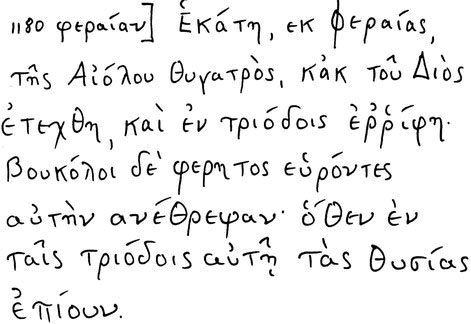
“Pheraia Hekataia, the daughter of Aiolos (the mythological earliest Greek settler of Thessaly', bore Zeus a daughter named Hekate Pheraia, who was abandoned at the crossroads. The Herdsmen of Pheres (who founded the city of Pheraia) discovered her there and brought her up. This explains why offerings are left her at the crossroads.” (cf. Theok. Id. 3: 36b.)(90). The actual relation of Hekate to Pheraia, that is their mutual identification whence the crossroads worship was included in the Hekate-concept, is here riddlingly set forth. We might more historically retell it to read “Pheraia, who is conflated with Hekate”, stands in maternal relation to Hekate inasmuch as Hekate inherits from her the crossroads-worship and pronounced infernal aspect. Since Hekate’s special relation to Zeus in the Theogony produced a tradition that Zeus fathered her, we may say Zeus and Pheraia are the parents of this late Hekate — suggesting thus the ambivalence of the Pheraia-Hekate conflation, grafting as it does a more chthonic goddess on one legitimized into the Olympian schema. Pherekycos of Athens, born c. 480, of whom little or nothing can be deduced from his scantily surviving works, calls Hekate simply “the daughter of Aristaios the son of Paion” (Apollo)(Sch. A.R. 3: 467; 3 fg. 44 J.) The meaning here is to be sought in the name Aristaios. The scholia (A.R. 3: 498-527a) recount that Pindar says in the 9th Pythia that Apollo begat upon his hunting companion the maiden Cyrene (after whom Cyrene in Libya is named) a boy, Aristaios; that Agraitas in his first book on Libya (fg. 2 M IV 294) states that : Cyrene was sister to Larissa, for whom the city in Thessaly is named; that some say Cyrene was the daughter of the Thessalian river Peneius. From this emerges essentially the same story as the Lykophron scholist gives: that Hekate is either the daughter or niece of a piece of Thessalian ‘theological geography’. Though we would express it differently, we are in perfect accord with the meaning of the genealogy: Hekate has inherited traits from a Thessalian deity. The most important indication of this new influence is the name Enodia, here reduced to a Hekate epithet. Its sense, ‘of the road’, suggests that it was through Enodia that Hekate came to take up her station at the crossroads. In support of this we have the watchers over Polyneikes’ body calling on Pluto and Enodia,((91) with reference to the custom of burying killers of their own close kin at the crossroads.(92) It is easy enough to see how two ‘mother goddesses’, one with a pronounced Mother aspect (Hekate), the other with a developed infernal character (Enodia) could consolidate to form the Hekate best known to us, the birth-helper and ghost-queen. The symbols best associated with each, the sacred pole (hekataion) and the crossroads (triodos) also fit together in a compelling way. The crossroads is a logical place to plant the sacred pole: it is already a symbolic intersection, a center. In Egyptian the glyph neywet a circle with an ‘x’ in it, representing a city with a crossroads, is used by itself to mean "city" and in compound with the word for “interior” henew to indicate the royal palace — itself a Center of highest religious significance. These usages hint at the archaic significance of the crossroads as a central intersection, not a random juncture of paths but a place on which roads purposefully converge, a Center. With this insight we can better appreciate the weirdness of a crossroads outside the city limits --it's like a city center without a city: roads all converging on nowhere. Prom here the development of the crossroads as a center that opens especially on the world of the dead is close. The chthonic possibilities of the crossroads seem in evidence also in ancient Japan, where the rituals of possession by marebito (gods, god-men, ancestral spirits, souls of the dead, etc.) which are the origin of the No plays, were earliest performed at the corner of a rice field or at a crossroads. Until recent times the Us. stage has preserved the cosmic symbolism of this latter: the actors stand for divine beings, the audience for earthly, and clay vases are placed under the stage to represent the subterranean regions.(93) Again, the crossroads as center is in play, but with an especially chthonic accent. The Hekataion having taken its place at Enodia's sacred site, and that tree symbol having taken nourishment from the dark soil of Enodia's meaning, the name Enodia would be characteristically used as a Hekate epithet when her baleful character was to be stressed, as in Ion: “Daughter of Demeter, Enodia hear. Propitious regent of each public way Concurrent with the Enodia syncretism is the appearance of the epithet antaia “encountering”; (meeting with). Nilsson sees this as referring to attack I by spooks who “come upon one suddenly” (G.G.R. 1:724).(95) This would complement the image of the crossroads as a place where ghosts could be encountered. It must be frankly avowed that although we are able to cite a number of factors that favored Enodia's syncretism with Hekate, we know virtually nothing about the goddess Enodia. In this section we have already given in full all the evidence about Enodia extant, which consists almost only of literary passages that use her name and attributes to describe Hekate. Enodia remaining mysterious, we cannot even responsibly speculate on why she was conflated with Hekate, but only state that she was, and what the effects on Hekate were. Hekate’s late syncretism with Enodia Antaia explains the problem of how Hekate comes to have at once a lar-like benign, household character -- and yet be the terrifying leader of a horde of angry ghosts. To be sure, “the one who dispatches ghosts can also restrain them”, as Nilsson offers (G.G.R. 1: 724) -- but that doubleness is scarcely adequate to account for Hekate-Enodia1s deep ambivalence on the level of popular religious practice, which echoes her somewhat inconsistent early and later literary depictions. Nor should it be supposed that by shifting responsibility for Hekate’s infernal nature to Enodia we have cleared the Greeks of any problematic relation to what these Goddesses represent. Enodia seems indeed to have been more pronouncedly infernal than Hekate, but infernal traits are normal for a fertility goddess. If Enodia was as rum a customer in Thessaly as she was in the Greek imagination, her widespread worship there would not have been possible. That the Greeks regarded her as they did probably tells us more about the Greeks and their relation to mother-goddesses than it does about Enodia. That Hermes, who was a god of roads, of the dead and of magic was never in the eyes of the Olympians the worse for it is striking evidence of what a difference Chthonic and Fertility associations made. The best evidence that Hekate-Enodia recieved truly prejudicial treatment is the inversion of innocent neolithic goddess qualities which would have originally coexisted with her dark side. We find this in Apollonius where we are treated to a full chthonic theophany of Hekate (by now conflated with Enodia.) Jason summons her, with rites almost identical to those Ulysses use to summon in the dead in Odyssey 10, whereupon 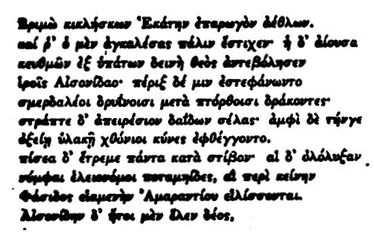 “...calling on Hekate Brimo to aid him in the contests. And when he had called on her he drew back; and she heard him, the dread goddess, from the uttermost depths and came to the sacrifice of Aeson’s son; and she was crowned with horrible serpents entwined among oak boughs; and there was a gleam of countless torches; and sharply howled around her the chthonic hounds. All the meadows trembled at her step; and the nymphs that haunt the marsh and the river shrieked, all who dance around that mead of Amarantian Phasis. And fear seized Aeson's son…” (Arg. 3. 1211-21)(96) Only some of these elements are truly chthonic and no doubt originally hers: these would be the emergence from underground (keuthmon ex hupaton - literally “from Hell's highest depth” or, to put it more poetically, “Hell's downmost altitude”), and the serpents in her head-dress like those of the Erinyes, and quite possibly the dead rites that opened contact with her (see below) and the scene's taking place at night. The river-nymphs who shriek in horror at Hekate's approach are another story: they are the earth-goddess' original associates, and their reaction is as bizarre as a river being frightened of the ground it irrigates (see below II: B: 3.) It should be recognized that part of the power the image has derives from its reversal of the ordinary relationship between an earth-goddess end her attributes. There is not only an aesthetic shock but a philosophic content to the image: in its reversal of the ordinary relations of Goddess to ground and water it suggests the topsy-turvy character of the realm of dead, for whom night is day, (97)). Perhaps it is in this spirit the torch has been transformed to “a gleam of countless torches” inundating the darkest hours with ghastly and inappropriate illumination. But appreciation of Apollonius' genius must not distract us from the point that this is a more purely baleful Hekate than we have seen before, unameliorated, as in earlier depiction, by gentle earth-motherly attributes. This is no longer a goddess who may be asked to "send visions favorably" but a fearful source of raw chthonic power. Hekate's pronounced death associations are then due to her conflation with the Thessalian Enodia in the 5th century. These lead to a highly demonized portrayal by the Hellenistic period, which is drawn on by Virgil and others for lines like: “nocturnisque Hecate triviis ululata per urbes” (Virg. Aen. 4: 609) It is from the Hellenistic period, and for a region extending from Italy to Asia Minor, that Peterson's second series of Hekataia date, and these show her with short torch, sword, dagger, whip, key and snakes. The shortening of the torch is probably a compositional consideration: a single figure would be balanced by a pair of torches as tall as itself as three Hekates around a pillar would not need to be. The key may be a very old feature, as the key-procession at the Lagina temple seems to suggest, but if so it is brought into new proficiencies as the key to Tartaros’ gates, such as described in Theokritos1 2nd Idyll. Sword, dagger, whip and snakes are probably referent to the furies. As mentioned above, these are the first interpretations of Hekate’s attributes to be offered unclouded by the lust for lunar symbolism, and are my own and tentative. Luna.By the fifth century BC the earlier Hekates we have considered — Artemis-like Mistress of the Animals, Helper in Contests, Great Mother and World-Tree were on their way to being, and by the Hellenistic period were, essentially subordinate to the morbid, ‘Enodial’ conception --at least by the poetic record. Whatever the original ingredients in the cauldron of Hekate's being, the basic flavor was now hellbroth. All this is altered in the Roman period, where Hekate is suddsnly identified with the moon. This was never the case in Greece, where the earliest clear identification with Mene or Selene appears only in the scholion to Theok. 2: 12: 14.(99) The scholia are all from the 2nd to 4th centuries AD -- which is when we also have clear lunar identification in the Magical Papyri. To be sure there is the witches' drawing down of the Moon (attested Aristoph; AP. RH.), and Hekate's “banquets” (100) set out at the crossroads on nights of the full moon (attest. Aristoph.) But association is not yet identification: it must be recalled that Theokritus can use the refrain phrazeo meu to eroth hothen hiketo potna Selana : “consider, mistress Selene, how my passion came about”, after the Hekate rite is completed, and in so different a tone as to suggest that there is no identity between the Moon and the fearful goddess of the crossroads. The novel conflation of Hekate and Luna, without Greek precedent, can only be explained by the powerful and developed Roman Moon conception. One might almost say the Moon was for the Romans what ‘Eleusis’ was for the Greeks (101) the most potent symbol of the sacrality of the agricultural cycle, and of that cycle’s use as a paradigm for existence. That the conception of the moon as mistress of Agriculture was a particularly Roman development, without debt to the Greeks, has been noted by Wilamowitz (Hellenist. Dichtg. 2: 289) -- though even he failed to grasp the remarkable centrality of the moon for the Roman religious world. Unlike the peripheral Selene or Mene, the Roman moon is placed among the twelve gods --by Varro at the beginning of his work on agriculture (de R. R. 1: 1: 5; similarly she prefaces Vergil's Georgics: “vos, o clarissima mundi In the same spirit Horace exhorts his chorus: rite Latonae puerum canentes rite crescentem face Noctilucam, prosperam frugum celeremque pronos volvere mensis (Carm. 4: 6: 37-40) As Cicero puts it: “…Luna.. .graviditates et partus adferat maturitat.es gignendi...” (Cic. De. Nat. Deor. 3: 119) In fact the Romans believed the moon affected all sublunary developments: wind, rain and tides, human and animal life, and even the “growth” of minerals and earthquakes: (104) but above all her influence is on the vegetable kingdom: “Luna larga est roris et dux humentium substantiarum. luna crescente omnes fructus erescunt atque ea minuente minuuntur”. (Suet. de. Nat, frg. 132.) There is much specific advice from Columella, Cato, Pliny and the other writers on agriculture on when to plant or harvest the various flora with reference to the lunar cycle ,(105) --in marked contrast to Hesiod, who takes his formerly cue from weather-signs, rainfall, bird and plant appearances, to the virtual exclusion of the moon except as an overall time-frame. The Romans considered Agriculture to be the finest and most improving of pursuits (106) and so their valuation of the moon as the mistress of agriculture made her in a sense the very heart of their religious world. So powerful a goddess, whose content makes her clearly compatible with an Agricultural Great Mother, would of course tend to absorb late-arrived goddesses who shared symbolism with her. So it was with Isis: introduced to Rome in the early first century and extremely popular, she is described in book 11 of Apuleius’ Metamorphoses -- which is indeed the most circumstantial document we possess about any ancient mystery religion, (given in full in Appendix Three) Apuleius describes her explicitly as a Lunar theophany. However, there is no record of Isis having possessed lunar features in Egypt — the moon god there, Khons, being a minor figure like Selene. We must assume that the Great Mother character which was indisputably Isis1 facilitated a rapid and complete assimilation with Luna. We cannot be surprised if the same happened with Hekate, who possessed not only this but a rather full panoply of lunar symbolism and favoring traits. Since none of these were prerequisite for the conflation, nor do they (for the most part) appear as significant features of the Lunified Roman Hekate, we will give them in detail in Endnote One to this chapter. In this place we shall simply state that Hekate the Great Mother from Asia Minor, a goddess of fertility, chthonic and womanly qualities, with a geographically determined oceanic dimension, equipped by the nature of Greek chthonic rites with the dog and snake as symbolic animals (107), and certainly given magical and death emphasis by Enodia, would, by the Hellenistic period, have virtually the entire Symbolism in place. In Endnote Two we offer some political considerations that may have brought more attractive force to the Roman moon goddess at exactly this time. Another point favoring conflation of Roman Luna with Hecate - one which Mircea Eliade does not develop in his primary discussion of the lunar symbolism is the role of the moon as limen of existence, as a point of transition. The Moon is by many cultures seen as the place to which the dead go, often a way-station for reincarnation; thus in the Bhagavad-Gita we find this comment on the fate of the soul at death: on the one hand there is the transition, via the moon, to Brahman: “Some to return, some never to return athletes of the spirit set forth when they pass on; the times [and seasons] of them all I shall [now] declare. Fire, light, day, [the moon's] light [fortnight], the six months of the [sun's] northern course, -- dying in these to Brahman do they go, the men whom Brahman know”. (B.G. 8: 23-24) “Those who know this as well as those who worship in the forest knowing that self-mortification is the same as faith, merge into the flame [of the funeral pyre]; from the flame [they pass on] into the day, from the day into the half-month of the full moon, from the half-month of the full moon into the six months during which the sun moves northwards, from [those] months into the year, from the year into the sun, from the sun into the moon, from the moon into the lightning. There is a Person who is other than human. He leads them on to Brahman. This path is the “way of the gods”. Those who fail, to attain this liberation use the moon as a way-station to the reincarnation. “But those who in their villages lay great store by sacrifice, good works, and the giving of alms, merge into the smoke, from smoke [they pass on] into the night, from the night into the latter half of the month, from the latter half of the month into the six months when the sun moves southwards. These do not reach the year. From [those] months they [merge] into the world of the ancestors, from the world of the ancestors into space, from space into the moon which is King Soma, the food of the gods. This the gods eat up. There they remain until the residue to their good works] is exhausted, and then they once again return on the same path. [They merge] into space, and from space into wind. After becoming wind, they become smoke; after becoming smoke they become mist; after becoming mist, they become cloud; after becoming cloud, they pour forth as rain. [Then] they are born here as rice or barley, herbs or trees, sesame or beans. To emerge from these is very difficult. For only if someone or other eats [him as] food and pours [him out] as semen, can he be born again”. (108) One recognises here the interweaving of the moisture and agricultural associations as well. Whatever lacks these qualities, whatever is false and spurious and full of error, belongs to the region between the earth and the moon (the last of all the heavenly bodies) and to the surface of the earth.(109) Noble spirits, Lucan informs us, are capable of ascending to the Moon, the utmost height a human can attain to short of godhood: “At non in Pharia manes iacuere favilla nee cinis exiguus tantam conpescit umbram; prosiluit busto semustaque membra relinquens degeneremque rogum sequitur convexa Tonantis. qua niger astriferis conectitur axibus aer quodque patet terras inter lunaeque meatus, semidei manes habitant quos ignea virtus innocuous vita patientes aetheris imi fecit, et aeternos animam collegit in orbes: non illuc auro positi nee ture sepulti perveniunt. illic postquam se lumine vero implevit, stellasque vagas miratus et astra fixa polis, vidit quanta sub nocte iaceret nostra dies risitque sui ludibria trunci”. (Luc. Phar. 9: 1-14.) “But the spirit of Pompey did not linger down in Egypt among the embers, nor did that handful of ashes prison his mighty ghost. Soaring up from the burning-place, it left the charred limbs and unworthy pyre behind, and sought the dome of the Thunderer. Where our dark atmosphere — the intervening space between the earth and the moon's orbit joins on to the starry spheres, there after death dwell heroes whose fiery quality has fitted them, after guiltless lives, to endure the lower limit of the ether, and has brought their souls from all parts to the eternal spheres: to those who are coffined in fold and buried with incense that realm is barred. When he had steeped himself in the true light of that region and gazed at the planets and the fixed stars of heaven, he saw the thick darkness that veils our day and smiled at the mockery done to his headless body”.(110) The moon then is the ultimate and spiritual limen of human existence. (111) The extension of this idea to include initiation, the journey through symbolic death into a reborn life imbued with sacred meaning, and all other such formulations of and all other “breakthrough in planes” is almost inevitable and would harmonize with Hecate’s ‘World-Tree’ aspects; In Augustine's formulation: “Lunam per omnes menses nascitur, crescit, perficitur, minuitur, consumitur, innovatur. Quod in luna per menses, hoc in resurrectione semel in toto tempore. (Sermo 361, De Resurr.; PL, 39, col. 1605) Similarly we have the moon-representations on Roman sarcophagi as symbols of Pythagorean theory on the destiny of the soul after death, combining ancient Hellenic and Oriental beliefs as taken up by Eleatic Stoics in the time of Posidonius.(112) Taken together, these two conceptions, of the moon as threshold of mortal and immortal existence and at the same a symbol of crossing that threshold, elliptically produce the notion of an intermediary. So it seemed to Plutarch who compared the moon to the demi-gods (daimones) who are intermediaries between gods and men: 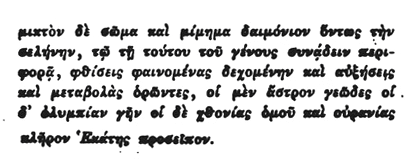 “But there is a body with complex characteristics which actually parallels the demigods, namely the moon; and when men see that she, by her being consistently in accord with the cycles through which those beings pass, is subject to apparent waxing and waning and transformations, some call her an earth-like star, others a star-like earth, and others the domain of Hecate”.(113) (Plut. de Defect. Or. 416 E) We have now reviewed the principal characteristics which determined Hekate's swing into the lunar orbit. To these must be added the Roman Luna's possession of a triplicate identity. Certainly Hekate possessed a triple form by the fifth century, but note, the Greek Hekate did not until the Roman period posses a meaningfully differentiated threefold being. Thin enrichment of the Hekate conception will prove to be purely Roman. There is ample evidence of an ancient and complex worship of the moon at Rome.(114) One the one hand we have old record of a cult of Luna at Rome as attested in inscriptions and by antiquarians,(115) and on the other the moon's three phases are identified with specific deity names as far back as the Latin literary record extends. These personae we shall here examine in detail. Before this a caveat is in order. We cannot here enter into a general discussion of the origin of the many epithets, Greek and Latin, which Roman poets used for the moon, (e.g., Cynthia, Dictynna, Noctiluca, Diviana, Latonia, Titania, Phoebe.)(116) These are in general merely employed for poetic color, with meaning provided only by context. They shall be described as and if they become relevant.(117) The usual superficiality of the epithets and the folly of attempting to analyze them in undue depth may be shown by examples of Roman usage: Ovid in Book 2 of the Metamorphoses recounts a tale of the virgin huntress Artemis in which he calls her not only Diana, but also Trivia (416,) Dictynna (441.) Luna (453-4) and Cynthia (465.) The poet's only concern here is to vary the language. Similarly Virgil uses Trivia, without prejudice, of Diana the huntress (Vir. Aen. 10: 537; 11: 565, 836.(118) Having noted that the poets will not always observe the distinctions we are about to establish, we shall now attempt to demonstrate that three of the names -- Juno, Diana, and Proserpine -- are, unlike the others, used with regularity and precision of purpose to describe the three principal aspects of the Roman Moon Goddess. Our primary finding regarding the Roman veneration of the moon is that she was worshipped as a triple divinity before the introduction of Hekate, and that Hekate's influence on her is not earlier than the last quarter of the first century BC. Juno seems to have been the principal the deity the Romans anciently associated with the Moon. The Roman's closest approach to a ‘Great Mother’, she would be the most logical representative for the moon as the Romans viewed it. Juno's maternal and generative character, her oldest and most consistently attested, is most pointedly formulated in Horace’s Carmen Saeculare, where she is in line 1, Diana; 13, Ilythia; 14, Lucina; 15, Genitalis; these last three all being types of maternity, and Diana herself not without such associations. The context is an invocation to favor Augustus’ laws relating to marriage and childbearing. Consort of Jove and deity of the childbirth from the earliest days of the Republic, her own etymology is inconclusive(119) but her epithet, Lucina clearly refers to light, whether we take this as directly lunar or (with Dumezil (120) read it as a reference to her childbirth functions -- bringing into the light of life is perhaps irrelevant, since the Lunar association informs them both. This correct etymology was accepted, and added to, by the Romans themselves: “Luna resutnebat decimo nova cornua motu virque pater subito nuptaque mater erat. That the Calends, the “rebirth” of the lunar month, were sacred to Juno (122) is similarly indicative or a strong and archaic lunar association. Before we present the evidence for Juno's early triple formulation, we will first briefly describe the Dumezilian methodology which we shall employ in analyzing it. Dumezil has demonstrated the survival of Indo-European beliefs and their structures among the peoples who descend from them, most notably in the tripartite division of society, as royal/priestly, warrior, and agricultural or laborious. This is seen in the Hindu divisions of Brahmans, the sacerdotal group, Kshatriva. the royal, princely or warrior class, and the Vaiava, the agriculturalists, merchants and artisans, beneath which three groups were the subject, darker-skinned indigenous persons, the Sudra or serfs. Parallel is the Norse division of Warrior, Peasant and Serf classes. Needless to say the apportioning of functions is not always so neatly worked out as we find it in Plato’s formulation in the Republic, but the overall triple structure is clear. So in Rome we find the structure represented in the divine triad Jupiter-Kars-Quirinus. Dumezil's most famous work has been to show the survival of the structure in historicized accounts, e.g., with Romulus, the son of Mars, being preeminently the warrior type, but also the regal and priestly, particularly after his deification, and the survival of the Quirinus, the agricultural function, in the Sabine Titus Tatius whence Rome gains its wealth and its women. The finding which is most momentous for our research is that a great goddess, such as Juno, may be polyvalent, that is involve herself in several of the social fields, though without thereby sacrificing her own nature. (Dumezil makes the important point that it is not only where but how a god intervenes that must be examined to evaluate his function: thus Mars' involvement in agriculture does not make him essentially Quirinal since his work consists of defending and assuring the borders of the fields.) Ve have not the precise information one would like as to the character of Juno's multiple involvements, but we have clear and ancient evidence of them among the cities of Latium, particularly from Lanuvium where we find inscriptions to ‘IVNONE SEISPITI MATRI REGINAE’ (123). Dumezil gathers the scattered attestations to these aspects and shows that Juno Seispes, (“illam vestram Sospitam, quam tu nunquam, ne in somnis quidem, vides nisi cum hasta, cum scutulo...” “that Sospita of yours, whom you couldn’t even imagine without her spear and shield”, Cic. D. Natur. Deor. 1: 82) is a warrior character, while her qualifications of Mother and Queen are clearly enough referent to her Agricultural and Royal/Priestly character. There is another striking attestation of the triple moon-goddess from before the period of Hekate's influence. This is a later Republican denarius,(124) dated at 43 BC by stylistic features (shading of drapery, stylization of necklace, etc.) which form the signature of this engraver.(125) The recto has a portrait of P. Accoleius, of a distinguished Arician family, with the epithet Lariscolus.(126) The verso of the coin shows three female figures with linked arms, the one on the left holding a bow, that on the right a poppy. Behind them are cypress trees, (127) and a horizontal bar which symbolizes
their unity, like the Spartan dokana. the bars above and below the two upright lines, which look like the Roman numeral II and represent the twins Castor and Pollux.(128) Complementing the coins, we have inscriptions to Diana Triplex as umbrarum ac nemorum incola (CIL 6: 124. )(129) Alfoldi reads this coin as evidence of Hekate's early (as the 6th century) influence on Roman religious conceptions by tracing the depiction on this coin to Hesiod's Hekate. This assumption depends on the incorrect belief that Hesiod's Hekate had already incorporated Enodia, and that the coin shows Hekate as Huntress, Noon and Netherworld goddess.(130) We know, however, that the conflation with Enodia is not earlier than the fifth century, and that a meaningful differentiation of Hekate into three figures with distinct attributes is nowhere attested before the Roman period. The poppy and the bow held by the flanking figures would more logically define them as Proserpine and Diana with Juno Lucina in the center. If Hekate were represented here we would expect archaic Hekate attributes -- libation bowl and ewer, torch, basket of fruit, or those attributes which appear after the conflation with Enodia — snakes, horse, torch, dagger, or whip. That the coin is inscribed to Diana and not to Juno is explicable in that the Arician Accoleius would naturally be eager to exalt Diana, who was a goddess native to Aricia. Since he then represents Diana as merely the left-hand side of a triple goddess, we must infer that she was in fact subordinate to the threefold Juno-Lucina. Let us now examine the Italic Diana.(131) Originally a goddess from Latium, her sanctuary at Aricia, in the Alban hills, served as a center to the Latin confederation when the cities of Latium obtained recognition from Rome of their autonomy after the war from 498-93. In response to this political advancement of the shrine, a corresponding cult of Diana was established on the Aventine. As to her original nature, we have her name, whose root is cognate with dius meaning sky, and a little information about her Arician sanctuary, in a wood on the shore of a mountain lake, where she was served by a priest known as Rex Nemorensis, a slave or fugitive who could be replaced in his duties by anyone who killed him. Excavations have revealed a great number of ex votos in the shape of sexual organs or pregnant female figures. In her grove was the fountain of the nymph Egeria, named with reference to child-birth (e-gerere.) to whom women sacrificed for easy delivery.(132) The only one of her rites which we know in any detail is a torchlight procession involving slaves and women. “Saepe potens voti frontem redimita coronis femina lucentes portat ab Urbe faces”. (Ov. Fasti 3; 269-70) “Often doth a woman, whose prayer has been answered, carry from the city burning torches, while garlands wreathe her brows”.(133) “Cynthia! Sed tibi me credere turba vetat, cum videt accensis devotam currere taedis in nemus et Triviae lumina ferre deae”. (Prop. 2: 32: 8-10) “Cynthia! I'm prevented from trusting you by the fact the world is full of men with whom you might cheat on me, men who would be attracted when they see you go hurrying with kindled torches to worship at the Arician grove, carrying light for the goddess Trivia”. (134) Propertius description refers to the Ides (13th) of August, Diana's birthday; a holiday particularly celebrated by women and slaves (Plut. Quaest. R. 100.) the Dies Servorum. “…iamque dies aderat profugis cum regibus aptum fumat Aricinum Triviae nemus et face multa conscius Hippolyti splendet lacus; ipsa coronat emeritos Diana canes et spicula terget et tutas sinit ire feras, omnisque pudicis Itala terra focis Hecateidas excolit idus”. (Stat. Silv. 3: 1: 55-60.) And now the day had come, when the torch-smoke rises from Trivia's grove at Aricia, refuge of the runaways who reign there, and the lights twinkle on the like lake that knew the secret of Hippolytus (i.e. Diana once hid him there) Diana herself sets garlands on her faithful hounds, and polishes her arrows and lets the wild beasts free, while at its virtuous hearths all Italy separates the ides”.(Aug.13th) of Hecate (i.e., Diana. )(135) From all this it seems clear that Diana was an agricultural ‘Great Mother’ (the sacrifice of the ‘king’ consort would suffice by itself to make this point.) A lunar association cannot be responsibly drawn from the bare etymology, nor is the presence of torches to be blithely read as a sign of nocturnal and lunar rites --particularly since she was never connected with moon-phases in the Roman calendar (136). Her warlike character would seem to be due entirely to her sanctuary at Aricia serving as the capitol of the Latin federation (as we noted above,) and the reinforcement of this martial aspect by conflation with the militant Sospes aspect of Juno. That would certainly make sense of her appearing in the triple formulation in arms,(137) and her conflation with Artemis' huntress aspect. The great-mother character that was originally Artemis' and remained Diana's at Aricia would also be factors in conflation with Juno. We note that there is no record of ‘triple Diana’ prior to her coupling with Juno. We need to understand correctly why it is that Diana is triformis (absorption into triple Juno) and why the birth-helper aspect is so prominent (originally Diana's and Artemis', but certainly reinforced by conflation with Juno Lucina who as moon-goddess is the goddess of fertility par excellence,) and why the bow-bearing huntress aspect is so pronounced, though seemingly unrelated to lunar or fertility features (it remains as the warrior aspect of the triple Juno, as a trace Diana's political past in Aricia, and as mark of the re-interpretation of Diana in terms of Greek Artemis.) All previous commentaries have noted the conflation and merely attributed it to mythological imprecision, poetic license, or the influence of Hekate. None have understood that the archaic triple Juno is the sole basis for this conflation, and that it is meaningful and unaccidental. The identification of the Moon, and hence of Juno Lucina with Proserpine is as early as Ennius: From the fact that the Moon is wont to be under the earth as well as over it, Ennius' Epieharmua calls her Proserpina. Proserpina received her name because she, like a snake (serpens) moves widely now to the right, now to the left. Sarpara. (“to creep”, the verb from which we derive the words serpens), and proserpere (‘to crawl forward’) were used interchangeably in those days.(139) This mention, with the denarius noted above, constitutes virtually the entire dossier of Proserpine as the dark moon. We can assume this poverty of examples is in some measure due to Hekate's introduction into the formula -- the more poetically exotic name Hekate was simply preferred. As to Proserpine herself, there is record of Ceres at least being early made, interpretatione Graeca into an equivalent of Demeter, as inscriptions attest, from the end of the royal period,(140) and the rites of Dis (‘rich’, simple rendition of Plouton) and Proserpine (“Persephone”) were tactically introduced in the first Punic war (249 BC).(141) It can be remembered that in Greece Persephone is primarily known as a goddess of agriculture, hence the appropriateness of her conflation into the Roman triple moon-goddess, Juno-Lucina. It is to be noted that an infernal interpretation of Persephone, as queen of hell is not yet emphasized in either Greek or Latin treatments. This will come about largely due to Hekate-Enodia's superimposition on the Persephone aspect of triple Juno. We also note that there is no any clear-cut record of triple Proserpine before she is joined with Juno. We are arguing here that Hekate was introduced into Rome quite late, probably in the last decades of the first century BC. To substantiate this, we will note that Hecate or Trivia (the Latinization of Enodia) are never associated with what might seem to us the most logical persons and things: Compitalia, the crossroads cult, Mater Larum, Janus, the funerary holidays of the Feralia and the Lemuria. Had Hekate-Enodia been earlier naturalized at Rome, surely she would have found some mention in one of these contexts, all of which are described in the Fasti. But such mentions are entirely lacking. The earliest Latin literary record of Trivia is the frgament of Ennius: This poem from the end of the 1st century BCE is the earliest clear description of the Roman triple lunar deity, and the most complete from any period. Thus we will do well to here review the bases of our reading: Thus we can only conclude that basis of Catullus’ formulation of the triple goddess, as well as that of his predecessors and those who followed his example, was not Hekate, or Proserpine/Diana, but the Roman lunar and triple Juno Lucina. We add as an aside that one must not be led astray by the poet’s dim imagination to assume the conception of Dea Triplex was indistinct or confusing to the Romans: this is rather an instance of the legalistic circumspection with which they ordinarily approached deity: anxious lest they offend by the omission of a dignity or by exceeding their accurate knowledge of a deity's nature, they preferred to employ vague and unambitious phrases.(142) This formula does not then enfeeble the preceding characterizations, but rather stresses that they constitute the outline and limit of what the poet and his audience deemed sure, precise and proven knowledge. This religious circumspection is probably what accounts for the brevity of the identification of Juno with Trivia (i.e. Hekate-Enodia:) he gives it in a mere four words ‘tu potens Trivia...(e)s’. “You are powerful Trivia”. As for Hekate, the name does not appear in Latin literature before the generation of Horace, Propertius and Vergil, and it is striking that the only physical description of the goddess herself any of these authors offer is Vergil's: “tergeminamque Hecaten, tria Virginia ora Dianae”. (Vir. Aen. 4: 511) The goddess makes her appearance in the Aeneid precisely as in classical Greek statuary -- as a triple Artemis-figure. Almost as though Virgil had consulted sculpture to find out how to depict this novel goddess. A like unacquaintance with or indifference to the details of the Greek Hekate-Enodia is apparent in Ovid’s Hekate invocation in the Medea episode (Met. 7: 179 ff..). There the entire focus of the ritual is the moon, and indeed it may not take place till she shines out full. Lucan's brief notice (B.C. 6: 738-78, see App. 3,) will describe Hekate as having different visages, and use this to explain the contradictions of her celestial-infernal nature, but he is, among Latin poets, unique in this ‘hellenizing’ view of the Goddess. Apuleius will describe a Hekate who is entirely subordinate to the lunar-Juno conception, just as Ovid had: in both cases the Hekate mention is prefaced by a long description of the appearance and powers of the moon — given in Roman terms, strictly as the Mistress of all Growth, and in such language as cannot be convincingly traced back to the Greek descriptions of Hekate’s Great Mother role. It is clear then that Hekate virtually submerges in the ocean of the Latin Luna/Juno, and survives there superficially as at most an epithet or a descriptive detail, like an extinguished torch bobbing on the Luna-ruled waves. The only overall change Hekate-Enodia seems to have brought to the Roman Luna is a generalized association with magic. One further metamorphosis awaits Hekate, her reformulation in philosophical terms. We cannot here enter into the problems of Greek rationalism and its struggle with Greek religiosity: it must suffice to say that by the 2nd to 4th centuries CE many systems of belief had arisen which attempted a synthesis of philosophy and mysticism. The “Chaldaen oracles” are very sophisticated instance of this, the “Magical Papyri” a fairly ‘vulgar’ one. In the P.G.M. Hekate, more a some sort of ‘Great Premise’ than a ‘Great Goddess’, uses a bewildering variety of epithets, whose application to Hekate becomes clear only from context. The most frequent names are Selene, Hekate, Mono, Persephone Enodia and Artemis; somewhat more occasionally she is called Dike, Tyche, Brimo, the Furies, Night and Chaos. Titles, appellations and snippets of description alternate in kaleidoscopic wise -- we cannot consider this enumeration adequately explained by the intention of, with each detail, fixing the attention and compelling the influence of the deity. That mode is ancient, to be found wherever the locations of a deity's shrines and epithets are enumerated (e.g., the Homeric Hymns.) The difference lies in the fact that in archaic piety these attention-getters climax in reference to some myth, from which the present action or intention will analogically draw force. Hekate is here developed as Premise, a theological rather than a mythological being, and despite the verbose descriptions of the deity, there is never an allusion to mythos, only to principle. The papyri show Hekate as ruler of the unquiet dead and as the change-producing moon, but also extend these conceptions, particularly the lunar identification, to a far more encompassing because abstract character. Originally a goddess who supervised a cycle of organic growth, decay, and rebirth, she here becomes not the ‘effecter of change’ but Change itself, which the Greeks considered the essence of what was wrong with the material world: change entails decay and growth itself is thus a kind of death-sentence. The entire conception is given in the magical papyri with impressive continuity: On the one hand Hekate is the mother of all growth:  “...Mistress This is a part of Hekate's lunar character, for the moon's waxing and waning provides the pattern of all becoming:  “I call upon you who have all forms and many names, double-horned goddess, Hene, whose form no one knows except him who made the entire/ world, IAO, the one who shaped (you) into the twenty eight shapes of the world so that they might complete every figure and distribute breath to every animal and plant, that it might flourish, you who grow from obscurity into light and leave light for darkness (beginning to leave by waning).” (7:756-65)(144) As change, Hekate is called “...swift Tyche of daimons and gods..." (2602),  Hail, Holy Light, Ruler of Tartaros, The association which went from Growth to Change to Destiny ends with Doom: “...you're Justice and the Moira's threads: Klotho and Lachesis and Atropos..." (PGH 2795-97.) (145) Bets.  “Necessity But both growth and decay, creation and doom, are encompassed by the cosmic Hekate:  Beginning Special note: Hekate's early lunar attributes.First there is her genealogy: the night-sky sound of some of her closer relatives -- her (by Hesiod's account) grandmother was Phoibe and her mother Astoria. To this should be added the want of a compelling Greek moon god -- Selene and Hene are hardly more than ciphers. Certainly of prime importance was Hekate's being cousin to the sun-god Apollo((148) , and indeed, his sister insofar as she is fused with Artemis. An antipodal relation to the sun could well have made Hekate lunar and funereal.(149) It may be as counterpoise to the sun that Hekate appears already in the Hymn to Demeter (quoted above, where (Dem. : 25-26), besides Demeter herself, only Hekate and Helios hear the cries of abducted Persephone. Helios is a logical choice here: he sees all that happens on Earth. Hekate, if her mention in this context and emergence from a cave are not chance phenomena, is likely the second witness as one who is aware of what happens under the earth (or perhaps at night.) Similar in purport are the lines in the Argonautica where Apollonius has Medea swear: “Be witness the sacred light of Helios, be witness the rites of the maiden that wanders by night...”. (150) Hekate is Helios' nocturnal/underearth counterpart. Along with this rather formal connection to the moon, Hekate comes to possess virtually every feature of the lunar Symbolism. To organize the scattered and sparse material we shall here adopt the archetypal framework. After, we shall survey our findings historically. The moon, by its apparent cycles of growth and decay has universally suggested the process of birth, becoming, death and renewal. This should be adequately represented by our above quotations in relation to and agriculture, etc. Those areas of nature which fall under the law of recurring cycles -- water, rain, plant life, and fertility -- are governed by the moon. To sum the entire concept-constellation I will borrow Eliade's very concise if somewhat uncouth formulation “Moon-Rain-Fertility-Woman-Serpent-Death-Periodic Regeneration”.(151) Hekate's qualifications as a lunar divinity by this most demanding because fully articulated definition are as follows:
But Melanthios (c. 350-270, published an Attis and a special work on the Eleusinian Mysteries), in his work On the Eleusinian Mysteries, mentions among creatures sacrificed to Hekate not only the red mullet (triele) which sounds like "triple" and so is appropriate for her, but also the sprat, which has no special aptness beyond its being a sea creature, for Hekate is a sea-goddess also (my emphatic italics.)(hoti kai thalattios he Hekate) (Ath. Deip. 7: 325c -FGrHist 326 F2.) Artemis might also have been significant in the watery way:(153) in Callimachus’ Hymn to Artemis we find our completest description of the goddess, which is probably to be taken as reflecting early conceptions of her, as is to be expected from the author's antiquarian bent, and as seems confirmed by the absence of syncretism with Hekate (154) In this poem Zeus promises: 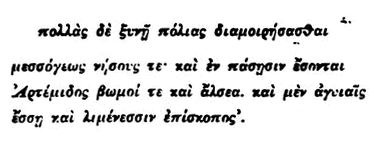 “... and many cities will I give thee to share with others, both inland cities and islands; and in them all shall be altars and groves of Artemis. And thou shalt be Watcher (episkopos) over Streets and Harbors.” (Cal. Hymn 3: 36-39)(155). In addition we have an Artemis who is Limnatis (Harbor-Goddess) in Pausanius – 4.4.2. Hekate's and Artemis' association with the sea is logical and probably inescapable for a Great Goddess worshipped not very far inland (Hekate is virtually on the trading coast of Asia Minor.) We stand by our earlier identification of Hekate as primarily an earth goddess, and attribute her oceanic associations primarily to geography. The “snake” in Eliade's formulation refers to any animal which disappears and reappears "renewed" as the moon does. Lunar animals from other cultures include the bear, which appears and disappears with the seasons, the snail which withdraws into its shell-- by its material and spiral itself a lunar symbol.(156) The dog is a lunar animal due to its nocturnal habits and its being seen in the moon. Likewise lunar is the serpent which periodically sloughs its skin and is “reborn”. (157) Hekate is associated both with the dog, who is sacrificed to her and whose barking fanfares her approach (attest. Sophron, AP. RH, discussed in I: C: 1,) and the serpent, seen in her fury-like crown, a standard feature from Sophocles on. The “fertility-woman” part of the formulation has been set forth further and will be amplified when we consider that she is, in all our literary records, a goddess exclusively invoked by women. All this comes under the heading of Asia Minor's Great Mother Ur-Hekate. Hekate's funereal aspects, insofar as they are especially stressed, derive particularly from Enodia, as has been discussed above. The implications of the “Death-Periodic-Regeneration” formulation, which contain the Symbolism's existential content, are intrinsic to the Great Mother's Birth-Death-Rebirth role. Special note: Politics and Juno-Hekate.Goddesses, especially Juno and Venus, enjoyed an extraordinary popularity in Roman religion from the third century on: Cybele was imported and became influential during the Punic wars; Venus was the patroness of the Julian house, etc., on to Isis and Mary.(158) This is not a uniquely Roman phenomenon; female deities characteristically embody opposites, both morphological (as, childbirth and virginity) and as regards affects and qualities, (as, Love and Anger.) This polymorphous character makes them natural vehicles for syncretism and supremely adaptable. Also, goddesses tend to be intercessory and sheltering, which makes them rallying-points in tumultuous times.(159) Thus Juno, qua goddess, would naturally gain in influence in times of civil war, which describes virtually the entire period in question here. Also, it must be remembered, that as the moon Juno was the goddess par excellence. Any goddess challenging Juno's domain over her particular functions, especially lunar- fertility, must either absorb her or be absorbed by her. Hekate is simply annexed as the lowest part of the Juno-triad. The absorption of Hekate by triple Juno, though favored by many shared traits, was then an entirely inevitable development, due to the enormous aggrandizement of that deity in the period.
PREVIOUS CHAPTERNEXT CHAPTERREFERENCES(1) Kehl, R.L., pp. 313-315. |